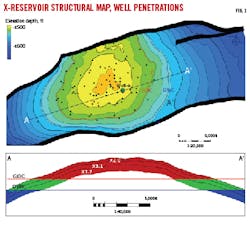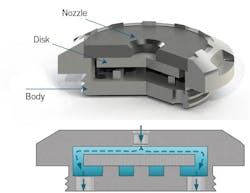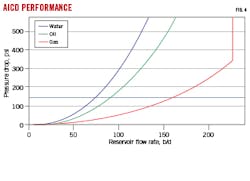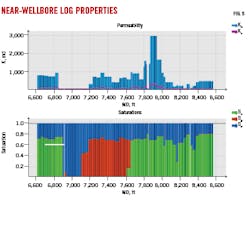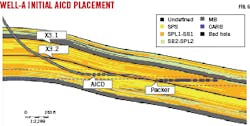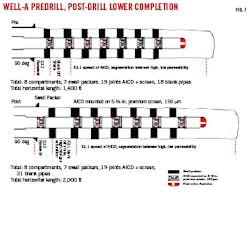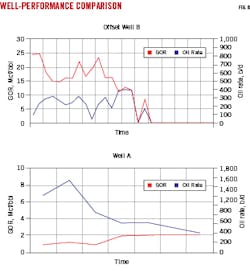Autonomous inflow device improves production in Malaysian thin oil rim
Fuziana Tusimin
Latief Riyanto
Norbaizurah Ahmad Tajuddin
Petronas Carigali Sdn. Bhd
Kuala Lumpur
Mojtaba Moradi
Tendeka
Aberdeen
Raam Marimuthu
Tendeka
Kuala Lumpur
Michael Konopczynski
Tendeka
Houston
Based on “Enhanced Oil Production with Autonomous Inflow Control Devices in a Thin Oil Rim Reservoir, Malaysia,” OTC-30363-MS, Offshore Technology Conference Asia, virtual event, Nov. 2-6, 2020.
Reservoirs developed with horizontal wells can experience early water and gas breakthrough due to variations in fluid properties, petrophysical properties, layer pressures, and fluid contacts across the lateral. Reduced oil recovery is often the result. Inflow control devices (ICDs) manage reservoir fluid influx along the wellbore to optimize well performance.1-6
In 2018, an infill development campaign for Petronas Carigali Sdn. Bhd improved production by using a new autonomous inflow control device (AICD) completion in a complex offshore oil reservoir at Sarawak, northwest of Borneo.7 8 AICDs differ from ICD’s in that they have active chokes that continuously adjust based on fluid properties and flow rates through the device.
Well plan
Field B is offshore Malaysia and has been producing for more than 45 years. Reservoir X is one of the main oil reservoirs in the field and is subdivided into three subunits, X2.0, X3.1, and X3.2 based on continuous sand sheet deposition in a shoreface setting ranging from upper-middle to lower shoreface and transitional zones (Fig. 1). No seismically discernable faults are present within the main structure. Reservoir X receives aquifer support from both west and east, with stronger trend from the east. Recoverable reserves are to be optimized through balancing gas and water injection as well as infill wells.
Well A was drilled near the crest of the structure as a horizontal well in a thin formation. With oil rim thickness averaging 13 ft, this was the thinnest AICD application to date (Fig. 1). The well intersects two geological layers with different properties. A large gas cap and aquifer are above and below the well, respectively. Oil production was expected to reduce significantly due to a high probability of early water and gas breakthrough, potentially within days or weeks of initial production.
These circumstances made it critical to optimize stand-off distance from gas-oil contact (GOC) and oil-water contact (OWC) and to install suitable technology for sustainable long-term production.
Workflow elements included:
- Pre-drilling studies, including AICD flow-loop testing.
- Well candidate selection.
- Flow performance evaluation with static and dynamic modelling.
- Post-drilling analyses with real-time completion design, history matching, and production data comparison with nearby wells.
Based on offset wells, anticipated structural uncertainty was 25 ft true vertical depth subsea (TVDSS), greater than the oil column thickness. This made building the deviation angle while drilling and landing the horizontal well in the thin oil column difficult.
The maximum dogleg severity (DLS) of the openhole horizontal section had to be limited to no greater than 3°/100 ft to reduce running forces and bending stresses during lower completion installation, especially of the screen and swell packer. This was confirmed through torque and drag analysis.
A significant difference appeared between expected and actual permeability in one of the subunits, impacting its completion strategy. Real-time decisions based on the actual data were needed to optimize completion design.
AICD
Like an ICD, the AICD is designed to proactively balance influx of reservoir fluids, delaying production of unwanted effluents before breakthrough. Unlike a passive ICD with no moving parts, once breakthrough occurs the AICD reactively restricts production of unwanted effluents with lower viscosity such as gas in light oil, or gas and water in viscous oil.
Fluid enters the device through an orifice in the top plate, impacting a levitating disk and dispersing fluid radially between the disk and top plate (Fig. 2). Fluid flows around the periphery of the disk to exit the device through an array of ports at the bottom of the device. Flow restriction is accomplished by dynamically changing the position of the floating disk. The degree of choking between the space above the disk is determined by balancing three principal forces: momentum force, frictional pressure drop, and lifting force. The last of these is created by reduced pressure from high velocity fluid in the gap between the disk and the top plate per Bernoulli’s constant energy equation. One valve is at the top of each screen section, above the basepipe inlet (Fig. 3).
Field B employs 7.5-mm AICD valves to match device performance to well flow rate requirements. Oil viscosity is 0.67 cp, water viscosity is 0.37 cp, and gas viscosity is 0.02 cp. When gas or water flows through the AICD valve at the same drawdown, velocity of water and gas will increase and reduce the dynamic pressure, levitating the disk toward the inlet to choke flow.
The AICD valve is assembled as part of the sand screen joint. The size of the device is interchangeable at the rig site if calibration modelling using post-drilling log data suggests different conditions than expected. Dynamic reservoir simulations are required to quantify the production benefits of the AICD completion over field life. Fig. 4 shows single-phase AICD performance at Reservoir X conditions.
Simulating several production scenarios depicting unwanted fluid breakthrough quantified later-life well performance with the AICD completion. The scenarios optimized AICD completion design.
Well completion
Based on petrophysical analysis, a thick shale section was expected from 6,907-7,187 ft. Reservoir subunit X3.2 is estimated to have 5 ft of standoff from the OWC at the heel of the well and is prone to early water breakthrough. Meanwhile, the top of subunit X3.1 is closer to the GOC with more than 60% gas saturation from 7,187-7,667 ft. This section of the wellbore is susceptible to early gas breakthrough.
Blanking off this high gas zone would be the ideal solution to mitigate early gas production. The mid and toe sections of X3.1 contain good oil saturation which requires more AICD joints for improved well production.
Fig. 5 shows near-wellbore reservoir permeability (K), horizontal permeability (Kh), vertical permeability (Kv), oil saturation fraction (So), water saturation fraction (Sw), and gas saturation fraction (Sg) obtained from logs after reaching target depth. Reservoir permeability averaged 1,000 md with a high permeability zone at 7,852–8.032 ft.
Observed reduction in oil rim thickness at Well A necessitated reevaluation of both remaining recoverable reserves and well placement strategy. First, an analytical study identified the need for a new drainage point in the southeast area of Reservoir X. Secondly, a fit-for-purpose dynamic model was constructed to:
- Understand impact of a thinner-than-expected oil rim on recoverable reserves.
- Optimize stand-off distance from GOC and OWC in Well A.
- Design the AICD well completion.
A segmented well model represented the proposed AICD placement in the dynamic simulation reservoir model. The investigation used multiple parameter sensitivities to evaluate impact on oil production due to thinning of the oil leg column. The investigation also estimated timing and extent of early water and gas breakthrough. Based on the analysis, optimized horizontal depth placement is 1/3 stand-off distance from the GOC and 2/3 from OWC to sustain well life and recover new estimated reserves.
Multiple simulation runs tested the sensitivity of production rates and recovery efficiency versus the number of AICDs and packer placement for horizontal section segmentation. Oil, gas, and water rates were compared at two timesteps: initial and end of well life. The simulations found that GOR can be reduced by 46% after gas breakthrough compared to a standalone screen completion. Oil production can increase up to 50% with constant downhole rate control via two AICDs mounted on each joint of 5 ½-in., 150-mm premium sand screen.
Segmentation analysis recommended seven producing compartments with seven swell packers to achieve better inflow control. For the upper completion, tubing size was 3 ½ in., equipped with a gas lift mandrel to kick off the well for production. Initial design for Well A is shown in Fig. 6.
Application of real-time reservoir mapping-while-drilling enabled evaluation of oil column thickness in both X3.1 and X3.2 reservoir subunits. Oil rim in X3.2 was 17-ft thick and shallower than expected, while oil rim in X3.1 was deeper than observed in Well B and was interpreted to have a 25-ft oil column.
Well A was drilled to final target depth (FTD) with 2,000-ft total horizontal length. The original design was limited to 1,400 ft by material availability, but additional 5 ½-in. blank liner joints were secured which enabled completion to the total drilled horizontal length. Using post-drilling results, real-time inflow control simulation was rerun to confirm final placement of AICDs before the completion operation.
For the analysis, several scenarios were simulated by manipulating late-time fluid saturation to mimic breakthrough scenarios and observe AICD performance along the horizontal section. Inflow control simulation considered the possibility of early water breakthrough from X3.2 via the 5-ft OWC standoff at the heel, early gas breakthrough at the top of X3.1, and significant permeability differences along the horizontal penetration within X3.1. The strategy was to limit AICD joints in X3.2 to restrict water inflow, to blank-off high gas saturation zones in X3.1, and to limit AICD joints at the high permeability intervals.
Evaluation of late-life AICD performance considered several completion designs to examine functionally of AICD completion and quantify its impact on well productivity. The final completion design was compared with the pre-drill plan in Fig. 7. Ultimately, a total of seven swell packers and 18 AICD joints were installed.
Results
Well A was successfully drilled within the thin oil rim, optimally placed, and completed with screens, swell packers, and AICDs. Drill-in and completion fluids were unloaded from the well to establish communication between wellbore and reservoir. The well flowed at an instantaneous rate of 3,140 b/d with 8% water cut. Gas rate was monitored to measure AICD effectiveness. Initial readings were low and comparable to solution GOR.
The dynamic model was subsequently updated with observed contacts, actual well trajectory, and final completion design. Several withdrawal scenarios were performed. Greater withdrawal rates increased pressure drawdown and caused earlier water coning. Controlling Well-A drawdown, therefore, is identified as one way to mitigate coning and sustain oil production for a longer period.
Fig. 8 shows the performance comparison of Well A, completed with the AICDs, and Well B, with another completion. Although Well B showed significant GOR reduction (from 25 Mcf/bbl to less than 1 Mcf/bbl) at initial testing, it was later shut in due to excessive gas production. Well A, however, is still producing at a high oil rate while maintaining a stable 2 Mcf/bbl GOR.
References
- Ahmad, F., Al-Neaimi, A.K., Saif, O.Y., Channa, Z., Iwama, H., Sarsekov, A., and Abazeed, O., “Rejuvenating a High GOR, Light Oil Reservoir Using AICD Completion Technology for Gas Control,” SPE-183486-MS, SPE Abu Dhabi International Petroleum Exhibition and Conference, Abu Dhabi, Nov. 7-10, 2016.
- Dowlatabad, M.M., “Novel Integrated Approach Simultaneously Optimising AFI Locations Plus Number and (A)ICD Sizes,” SPE-174309-MS, SPE EUROPEC 2015, Madrid, June 1-4, 2015.
- Halvorsen, M., Madsen, M., Vikøren Mo, M., Isma Mohd, I., and Green, A., “Enhanced Oil Recovery on Troll Field by Implementing Autonomous Inflow Control Device,” SPE-180037-MS, SPE Bergen One-Day Seminar, Bergen, Norway, Apr. 20, 2016.
- Moradi, M., Konopczynski, M., Ismail, I. M., and Oguche, I., “Production Optimisation of Heavy Oil Wells Using Autonomous Inflow Control Devices,” SPE-193718-MS, SPE International Heavy Oil Conference and Exhibition, Kuwait City, Dec. 10-12, 2018.
- Ismail, I.M., Che Sidik, N.A., Wahi, S.F., Tan, G.L., Tom, F., and Hillis, F., “Increased Oil Production in Super Thin Oil Rim Using the Application of Autonomous Inflow Control Devices,” SPE-191590-MS, SPE Annual Technical Conference and Exhibition, Dallas, Sept. 24-26, 2018.
- MoradiDowlatabad, M., Muradov, K.M., and Davies, D., “Novel Workflow to Optimise Annular Flow Isolation in Advanced Wells,” IPTC-17716-MS, International Petroleum Technology Conference, Kuala Lumpur, Dec. 10-12, 2014.
- MoradiDowlatabad, M., Zarei, F., and Akbari, M., “The Improvement of Production Profile While Managing Reservoir Uncertainties with Inflow Control Devices Completions,” SPE-173841-MS, SPE Bergen One Day Seminar, Bergen, Apr. 22, 2015.
- Tajuddin, N.B.A., Dan, H.X., Tusimin, F., Kawar, S., Feisal, S.M.R., Ali, N.A.W., Shah, J.M., Riyanto, L., Hussain, M., Fadzil, N.A.A., and Sakdilah, M.Z., “Successful Monetisation of an Extremely Thin Oil Rim and Slanted Contact Reservoir,” SPE-196513-MS , SPE/IATMI Asia Pacific Oil and Gas Conference and Exhibition, Bali, Oct. 29-31, 2019.
The authors
Fuziana Tusimin ([email protected]) is a production technologist at PETRONAS Carigali Sdn. Bhd, Kuala Lumpur. She holds a BE (2007) in chemical engineering from University Technology Petronas, Malaysia. She is a member of Society of Petroleum Engineers (SPE).
Latief Riyanto ([email protected]) is a staff production technologist at PETRONAS in Kuala Lumpur. He holds a BS (1998) in mechanical engineering from Institut Teknologi Bandung and an MS (2000) in petroleum engineering from Institute Francais du Petrole (IFP). He is a member of SPE.
Nor Baizurah ([email protected]) is a reservoir engineer at PETRONAS Carigali Sdn. Bhd, Kuala Lumpur. She holds a Bachelor of Engineering (2006) from Vanderbilt University, Tennessee and is a member of SPE.
Mojtaba Moradi ([email protected]) is a reservoir engineer at Tendeka in Aberdeen. He holds a BS (2008) in petroleum engineering from Amirkabir University of Technology - Tehran Polytechnic and a PhD (2016) from Heriot-Watt University. He is a member of the Society for Industrial and Applied Mathematics (SIAM), the European Association of Geoscientists and Engineers (EAGE), and SPE.
Raam Marimuthu ([email protected]) is a senior application engineer at Tendeka in Kuala Lumpur. He holds a BS (2011) in petroleum engineering from University Technology Malaysia and is a member of SPE.
Michael Konopczynski ([email protected]) is a director of subsurface engineering at Tendeka in Houston. He holds a BS (1981) in mechanical engineering from the University of Toronto. He is a member of the Association of Professional Engineers and Geoscientists of Alberta (APEGA) and SPE.
